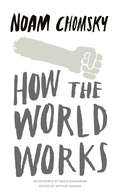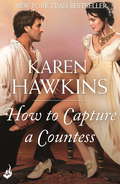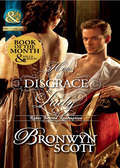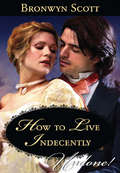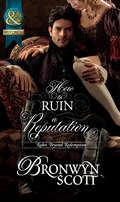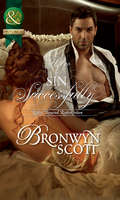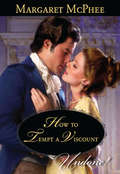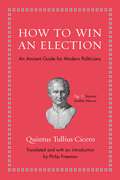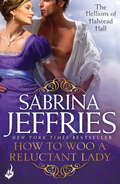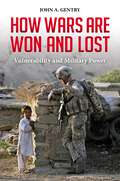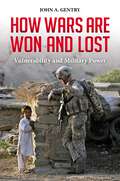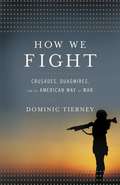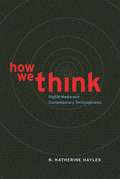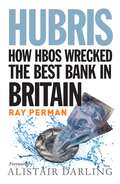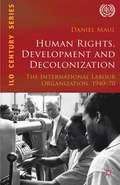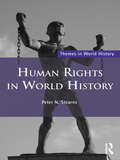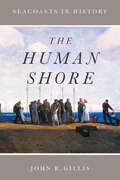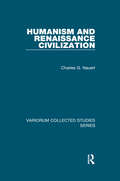- Table View
- List View
How the World Works (Real Story Ser.)
by Noam ChomskyWith exceptional clarity and power of argument, Noam Chomsky lays bare as no one else can the realities of contemporary geopolitics. Divided into four sections, originally published in the US only as individual short books, collectively selling over half a million copies, How the World Works covers:* What Uncle Sam Really Wants: the main goals of US foreign policy; the devastation caused abroad; the brainwashing at home* The Prosperous Few and the Restless Many: the new global economy; food and Third World 'economic miracles'; the roots of racism* Secrets, Lies and Democracy: the US, the CIA, religious fundamentalism; global inequality; the coming eco-catastrophe* The Common Good: equality, freedom, the media; the myth of Third World debt; manufacturing dissent
How To Capture A Countess: Duchess Diaries 1 (Duchess Diaries #1)
by Karen HawkinsA sensationally sexy and witty Scottish historical romance from New York Times bestseller Karen Hawkins. Perfect for fans of Julia Quinn, Monica McCarty and Julie Garwood. The Duchess Diaries are sure to delight: a dazzlingly romantic, sexy, and Scottish spin on fairytales.At seventeen, Rose Balfour fell wildly in love with Lord Alton Sinclair, nicknamed 'Lord Sin' for his notoriously wicked ways. When an illicit kiss led to Rose humiliating the rake in front of his laughing peers, she was forced to escape to the obscurity of the Scottish countryside. Six years later, Sin is intent on revenge. Convincing his aunt, the Duchess of Roxburghe, to invite Rose to her annual ball, he plans on making her the laughing stock of high society. But he didn't expect Rose to have bloomed into an alluring woman with the power to turn his nefarious plans upside down. As Sin and Rose enter a fiery battle of the sexes, it becomes more heated and passionate at every turn. Eventually, one will have to surrender ... but to vengeance, or love's deepest passion? Don't miss the rest of the Duchess Diaries series: Princess In Disguise, How To Pursue A Princess, and How To Entice An Enchantress. And mingle with more royalty in her fabulous Princes of Oxenburg series.
How to Disgrace a Lady: How To Disgrace A Lady / How To Ruin A Reputation (Rakes Beyond Redemption #1)
by Bronwyn ScottMERRICK ST MAGNUS: THIS RAKE’S REPUTATION FOR THE PURSUIT OF SHAMELESS DEBAUCHERY IS SOCIETY LEGEND!
How to Live Indecently (Mills And Boon Historical Undone Ser.)
by Bronwyn ScottViscount Jamie Burke: the master of the indecent proposition. Craving adventure, the beautiful Daphne de Courtenay leaves her usual sense of family duty at the society ball door and impulsively accepts the invitation of a dashing stranger who promises a night of unadulterated liberty!
How to Ruin a Reputation: How To Disgrace A Lady / How To Ruin A Reputation (Rakes Beyond Redemption #2)
by Bronwyn ScottASHTON BEDEVERE: RENOWNED LIBERTINE WHO CAN RUIN A REPUTATION QUICKER THAN OTHER GENTLEMEN CAN DRINK THEIR BRANDY
How to Sin Successfully (Rakes Beyond Redemption #3)
by Bronwyn ScottRIORDAN BARRETT: LAST RAKE STANDING
How to Tempt a Viscount (Mills And Boon Historical Undone Ser.)
by Margaret McPheeLondon, 1807 A disastrous start to their marriage caused Ellen to leave her husband, Marcus Henshall, Viscount Stanley. Instead of retreating in humiliation, Ellen has been busy learning how to transform herself from a timid girl into a confident, sensual siren.
How to Win an Election: An Ancient Guide for Modern Politicians
by Philip Freeman Quintus Tullius CiceroHow to Win an Election is an ancient Roman guide for campaigning that is as up-to-date as tomorrow's headlines. In 64 BC when idealist Marcus Cicero, Rome's greatest orator, ran for consul (the highest office in the Republic), his practical brother Quintus decided he needed some no-nonsense advice on running a successful campaign. What follows in his short letter are timeless bits of political wisdom, from the importance of promising everything to everybody and reminding voters about the sexual scandals of your opponents to being a chameleon, putting on a good show for the masses, and constantly surrounding yourself with rabid supporters. Presented here in a lively and colorful new translation, with the Latin text on facing pages, this unashamedly pragmatic primer on the humble art of personal politicking is dead-on (Cicero won)--and as relevant today as when it was written. A little-known classic in the spirit of Machiavelli's Prince, How to Win an Election is required reading for politicians and everyone who enjoys watching them try to manipulate their way into office.
How To Woo A Reluctant Lady: The Hellions Of Halstead Hall 3 (The Hellions of Halstead Hall #3)
by Sabrina JeffriesThe third book in the Hellions of Halstead Hall series by New York Times bestseller Sabrina Jeffries. Sabrina's wonderfully witty, sexy historicals will be loved by fans of Sarah MacLean, Eloisa James and Julia Quinn.When a charming rogue proposes she marry him to meet her grandmother's ultimatum, the Sharpe clan's strong-willed sister makes a tempting counteroffer that preserves her inheritance - and ignites his imagination. Lady Minerva Sharpe has the perfect plan to thwart her grandmother's demands: become engaged to a rogue! Surely Gran would rather release her inheritance than see her wed a scoundrel. And who better to play the part of Minerva's would-be husband than wild barrister Giles Masters, the very inspiration for the handsome spy in the popular gothic novels she writes? The memory of his passionate kiss on her nineteenth birthday has lingered in Minerva's imagination, though she has no intention of really falling for such a rakehell, much less marrying him. Little does she know, he really is a covert government operative. When they team up to investigate the mystery behind her parents' deaths, their fake betrothal leads to red-hot desire. Then Minerva discovers Giles's secret double life, and he must use all the cunning tricks of his trade to find his way back to her heart.For more deliciously romantic and sparkling historical romance, don't miss the rest of Sabrina's Hellions Of Halstead Hall books. And don't miss her other sensational series including: The Sinful Suitors, The School for Heiresses and The Royal Brotherhood.
How Wars Are Won and Lost: Vulnerability and Military Power (Praeger Security International)
by John A. GentryThis provocative book seeks to answer a most crucial—and embarrassing—question concerning the U.S. military: why the United States is so often stymied in military confrontations with seemingly weaker opponents, despite its "superpower" status.This fascinating book examines a question that continues to puzzle soldiers, statesmen, and scholars: why do major powers—including the ostensible superpower United States—repeatedly perform poorly against seemingly overmatched adversaries? And what can they, and the United States, do to better achieve their military objectives?How Wars are Won and Lost: Vulnerability and Military Power argues that beyond relying solely on overwhelming military might, the United States needs to focus more on exploiting weaknesses in their adversaries—such as national will, resource mobilization, and strategic miscues—just as opposing forces have done to gain advantage over our military efforts. The author tests the "vulnerability theory" by revisiting six conflicts from the Philippine War of 1899-1902 to the ongoing actions in Iraq and Afghanistan, showing again and again that victory often depends more on outthinking the enemy than outmuscling them.
How Wars Are Won and Lost: Vulnerability and Military Power (Praeger Security International)
by John A. GentryThis provocative book seeks to answer a most crucial—and embarrassing—question concerning the U.S. military: why the United States is so often stymied in military confrontations with seemingly weaker opponents, despite its "superpower" status.This fascinating book examines a question that continues to puzzle soldiers, statesmen, and scholars: why do major powers—including the ostensible superpower United States—repeatedly perform poorly against seemingly overmatched adversaries? And what can they, and the United States, do to better achieve their military objectives?How Wars are Won and Lost: Vulnerability and Military Power argues that beyond relying solely on overwhelming military might, the United States needs to focus more on exploiting weaknesses in their adversaries—such as national will, resource mobilization, and strategic miscues—just as opposing forces have done to gain advantage over our military efforts. The author tests the "vulnerability theory" by revisiting six conflicts from the Philippine War of 1899-1902 to the ongoing actions in Iraq and Afghanistan, showing again and again that victory often depends more on outthinking the enemy than outmuscling them.
How We Fight: Crusades, Quagmires, and the American Way of War
by Dominic TierneyAmericans love war. We've never run from a fight. Our triumphs from the American Revolution to World War II define who we are as a nation and a people. Americans hate war. Our leaders rush us into conflicts without knowing the facts or understanding the consequences. Korea, Vietnam, and now Iraq and Afghanistan define who we are as a nation and a people. How We Fight explores the extraordinary doublemindedness with which Americans approach war, and reveals the opposing mindsets that have governed our responses throughout history: the "crusade" tradition-our grand quests to defend democratic values and overthrow tyrants; and the "quagmire" tradition-our resistance to the work of nation-building and its inevitable cost in dollars and American lives. How can one nation be so split? Studying conflicts from the Civil War to the present, Dominic Tierney has created a secret history of American foreign policy and a frank and insightful look at how Americans respond to the ultimate challenge. And he shows how success is possible. His innovative model for tackling the challenges of modern war can mean longstanding victory in Iraq and Afghanistan, by rediscovering a lost American warrior tradition.
How We Think: Digital Media and Contemporary Technogenesis
by N. Katherine Hayles“How do we think?” N. Katherine Hayles poses this question at the beginning of this bracing exploration of the idea that we think through, with, and alongside media. As the age of print passes and new technologies appear every day, this proposition has become far more complicated, particularly for the traditionally print-based disciplines in the humanities and qualitative social sciences. With a rift growing between digital scholarship and its print-based counterpart, Hayles argues for contemporary technogenesis—the belief that humans and technics are coevolving—and advocates for what she calls comparative media studies, a new approach to locating digital work within print traditions and vice versa. Hayles examines the evolution of the field from the traditional humanities and how the digital humanities are changing academic scholarship, research, teaching, and publication. She goes on to depict the neurological consequences of working in digital media, where skimming and scanning, or “hyper reading,” and analysis through machine algorithms are forms of reading as valid as close reading once was. Hayles contends that we must recognize all three types of reading and understand the limitations and possibilities of each. In addition to illustrating what a comparative media perspective entails, Hayles explores the technogenesis spiral in its full complexity. She considers the effects of early databases such as telegraph code books and confronts our changing perceptions of time and space in the digital age, illustrating this through three innovative digital productions—Steve Tomasula’s electronic novel, TOC; Steven Hall’s The Raw Shark Texts; and Mark Z. Danielewski’s Only Revolutions. Deepening our understanding of the extraordinary transformative powers digital technologies have placed in the hands of humanists, How We Think presents a cogent rationale for tackling the challenges facing the humanities today.
How We Think: Digital Media and Contemporary Technogenesis
by N. Katherine Hayles“How do we think?” N. Katherine Hayles poses this question at the beginning of this bracing exploration of the idea that we think through, with, and alongside media. As the age of print passes and new technologies appear every day, this proposition has become far more complicated, particularly for the traditionally print-based disciplines in the humanities and qualitative social sciences. With a rift growing between digital scholarship and its print-based counterpart, Hayles argues for contemporary technogenesis—the belief that humans and technics are coevolving—and advocates for what she calls comparative media studies, a new approach to locating digital work within print traditions and vice versa. Hayles examines the evolution of the field from the traditional humanities and how the digital humanities are changing academic scholarship, research, teaching, and publication. She goes on to depict the neurological consequences of working in digital media, where skimming and scanning, or “hyper reading,” and analysis through machine algorithms are forms of reading as valid as close reading once was. Hayles contends that we must recognize all three types of reading and understand the limitations and possibilities of each. In addition to illustrating what a comparative media perspective entails, Hayles explores the technogenesis spiral in its full complexity. She considers the effects of early databases such as telegraph code books and confronts our changing perceptions of time and space in the digital age, illustrating this through three innovative digital productions—Steve Tomasula’s electronic novel, TOC; Steven Hall’s The Raw Shark Texts; and Mark Z. Danielewski’s Only Revolutions. Deepening our understanding of the extraordinary transformative powers digital technologies have placed in the hands of humanists, How We Think presents a cogent rationale for tackling the challenges facing the humanities today.
Hubris: How HBOS Wrecked the Best Bank in Britain
by Ray Perman Alistair DarlingIn 1995 Bank of Scotland celebrated 300 years as Britain's oldest commercial bank. Voted 'most admired bank', respected by competitors, applauded by investors and trusted by customers, it looked forward to the next three hundred. Less than 15 years later it was bust, reviled as part of the spectacular collapse of HBOS, the conglomerate it had joined. One of the high-profile victims of the credit crunch, its spectacular fall caused seismic shock waves throughout the financial world. What went wrong? Ray Perman, who has followed the Bank since the 1970s when he was a Financial Times journalist, uncovered the story from documents and dozens of interviews with people at the top in Bank of Scotland and HBOS - from being the bank of choice for the highrolling Monte Carlo mega-rich to losing GBP10 billion. It is a cautionary tale for our times. In the complex world of modern global finance, the brilliant men who ran the company ignored the simple banking rules that their predecessors learned the hard way three centuries before.
Human Rights, Development and Decolonization: The International Labour Organization, 1940-70 (International Labour Organization (ILO) Century Series)
by D. MaulAn innovative diplomatic and intellectual history of decolonization, post-colonial nation building and international human rights and development discourses, this study of the role of the ILO during 1940–70 opens up new perspectives on the significance of international organisations as actors in the history of the 20th century.
Human Rights in World History (Themes in World History)
by Peter N. StearnsDefended by a host of passionate advocates and organizations, certain standard human rights have come to represent a quintessential component of global citizenship. There are, however, a number of societies who dissent from this orthodoxy, either in general or on particular issues, on the basis of political necessity, cultural tradition, or group interest. Human Rights in World History takes a global historical perspective to examine the emergence of this dilemma and its constituent concepts. Beginning with premodern features compatible with a human rights approach, including religious doctrines and natural rights ideas, it goes on to describe the rise of the first modern-style human rights statements, associated with the Enlightenment and contemporary antislavery and revolutionary fervor. Along the way, it explores ongoing contrasts in the liberal approach, between sincere commitments to human rights and a recurrent sense that certain types of people had to be denied common rights because of their perceived backwardness and need to be "civilized". These contrasts find clear echo in later years with the contradictions between the pursuit of human rights goals and the spread of Western imperialism. By the second half of the 20th century, human rights frameworks had become absorbed into key global institutions and conventions, and their arguments had expanded to embrace multiple new causes. In today’s postcolonial world, and with the rise of more powerful regional governments, the tension between universal human rights arguments and local opposition or backlash is more clearly delineated than ever but no closer to satisfactory resolution.
Human Rights in World History (Themes in World History)
by Peter N. StearnsDefended by a host of passionate advocates and organizations, certain standard human rights have come to represent a quintessential component of global citizenship. There are, however, a number of societies who dissent from this orthodoxy, either in general or on particular issues, on the basis of political necessity, cultural tradition, or group interest. Human Rights in World History takes a global historical perspective to examine the emergence of this dilemma and its constituent concepts. Beginning with premodern features compatible with a human rights approach, including religious doctrines and natural rights ideas, it goes on to describe the rise of the first modern-style human rights statements, associated with the Enlightenment and contemporary antislavery and revolutionary fervor. Along the way, it explores ongoing contrasts in the liberal approach, between sincere commitments to human rights and a recurrent sense that certain types of people had to be denied common rights because of their perceived backwardness and need to be "civilized". These contrasts find clear echo in later years with the contradictions between the pursuit of human rights goals and the spread of Western imperialism. By the second half of the 20th century, human rights frameworks had become absorbed into key global institutions and conventions, and their arguments had expanded to embrace multiple new causes. In today’s postcolonial world, and with the rise of more powerful regional governments, the tension between universal human rights arguments and local opposition or backlash is more clearly delineated than ever but no closer to satisfactory resolution.
The Human Shore: Seacoasts in History
by John R. GillisSince before recorded history, people have congregated near water. But as growing populations around the globe continue to flow toward the coasts on an unprecedented scale and climate change raises water levels, our relationship to the sea has begun to take on new and potentially catastrophic dimensions. The latest generation of coastal dwellers lives largely in ignorance of the history of those who came before them, the natural environment, and the need to live sustainably on the world’s shores. Humanity has forgotten how to live with the oceans. In The Human Shore, a magisterial account of 100,000 years of seaside civilization, John R. Gillis recovers the coastal experience from its origins among the people who dwelled along the African shore to the bustle and glitz of today’s megacities and beach resorts. He takes readers from discussion of the possible coastal location of the Garden of Eden to the ancient communities that have existed along beaches, bays, and bayous since the beginning of human society to the crucial role played by coasts during the age of discovery and empire. An account of the mass movement of whole populations to the coasts in the last half-century brings the story of coastal life into the present. Along the way, Gillis addresses humankind’s changing relationship to the sea from an environmental perspective, laying out the history of the making and remaking of coastal landscapes—the creation of ports, the draining of wetlands, the introduction and extinction of marine animals, and the invention of the beach—while giving us a global understanding of our relationship to the water. Learned and deeply personal, The Human Shore is more than a history: it is the story of a space that has been central to the attitudes, plans, and existence of those who live and dream at land’s end.
The Human Shore: Seacoasts in History
by John R. GillisSince before recorded history, people have congregated near water. But as growing populations around the globe continue to flow toward the coasts on an unprecedented scale and climate change raises water levels, our relationship to the sea has begun to take on new and potentially catastrophic dimensions. The latest generation of coastal dwellers lives largely in ignorance of the history of those who came before them, the natural environment, and the need to live sustainably on the world’s shores. Humanity has forgotten how to live with the oceans. In The Human Shore, a magisterial account of 100,000 years of seaside civilization, John R. Gillis recovers the coastal experience from its origins among the people who dwelled along the African shore to the bustle and glitz of today’s megacities and beach resorts. He takes readers from discussion of the possible coastal location of the Garden of Eden to the ancient communities that have existed along beaches, bays, and bayous since the beginning of human society to the crucial role played by coasts during the age of discovery and empire. An account of the mass movement of whole populations to the coasts in the last half-century brings the story of coastal life into the present. Along the way, Gillis addresses humankind’s changing relationship to the sea from an environmental perspective, laying out the history of the making and remaking of coastal landscapes—the creation of ports, the draining of wetlands, the introduction and extinction of marine animals, and the invention of the beach—while giving us a global understanding of our relationship to the water. Learned and deeply personal, The Human Shore is more than a history: it is the story of a space that has been central to the attitudes, plans, and existence of those who live and dream at land’s end.
The Human Shore: Seacoasts in History
by John R. GillisSince before recorded history, people have congregated near water. But as growing populations around the globe continue to flow toward the coasts on an unprecedented scale and climate change raises water levels, our relationship to the sea has begun to take on new and potentially catastrophic dimensions. The latest generation of coastal dwellers lives largely in ignorance of the history of those who came before them, the natural environment, and the need to live sustainably on the world’s shores. Humanity has forgotten how to live with the oceans. In The Human Shore, a magisterial account of 100,000 years of seaside civilization, John R. Gillis recovers the coastal experience from its origins among the people who dwelled along the African shore to the bustle and glitz of today’s megacities and beach resorts. He takes readers from discussion of the possible coastal location of the Garden of Eden to the ancient communities that have existed along beaches, bays, and bayous since the beginning of human society to the crucial role played by coasts during the age of discovery and empire. An account of the mass movement of whole populations to the coasts in the last half-century brings the story of coastal life into the present. Along the way, Gillis addresses humankind’s changing relationship to the sea from an environmental perspective, laying out the history of the making and remaking of coastal landscapes—the creation of ports, the draining of wetlands, the introduction and extinction of marine animals, and the invention of the beach—while giving us a global understanding of our relationship to the water. Learned and deeply personal, The Human Shore is more than a history: it is the story of a space that has been central to the attitudes, plans, and existence of those who live and dream at land’s end.
The Human Shore: Seacoasts in History
by John R. GillisSince before recorded history, people have congregated near water. But as growing populations around the globe continue to flow toward the coasts on an unprecedented scale and climate change raises water levels, our relationship to the sea has begun to take on new and potentially catastrophic dimensions. The latest generation of coastal dwellers lives largely in ignorance of the history of those who came before them, the natural environment, and the need to live sustainably on the world’s shores. Humanity has forgotten how to live with the oceans. In The Human Shore, a magisterial account of 100,000 years of seaside civilization, John R. Gillis recovers the coastal experience from its origins among the people who dwelled along the African shore to the bustle and glitz of today’s megacities and beach resorts. He takes readers from discussion of the possible coastal location of the Garden of Eden to the ancient communities that have existed along beaches, bays, and bayous since the beginning of human society to the crucial role played by coasts during the age of discovery and empire. An account of the mass movement of whole populations to the coasts in the last half-century brings the story of coastal life into the present. Along the way, Gillis addresses humankind’s changing relationship to the sea from an environmental perspective, laying out the history of the making and remaking of coastal landscapes—the creation of ports, the draining of wetlands, the introduction and extinction of marine animals, and the invention of the beach—while giving us a global understanding of our relationship to the water. Learned and deeply personal, The Human Shore is more than a history: it is the story of a space that has been central to the attitudes, plans, and existence of those who live and dream at land’s end.
The Human Shore: Seacoasts in History
by John R. GillisSince before recorded history, people have congregated near water. But as growing populations around the globe continue to flow toward the coasts on an unprecedented scale and climate change raises water levels, our relationship to the sea has begun to take on new and potentially catastrophic dimensions. The latest generation of coastal dwellers lives largely in ignorance of the history of those who came before them, the natural environment, and the need to live sustainably on the world’s shores. Humanity has forgotten how to live with the oceans. In The Human Shore, a magisterial account of 100,000 years of seaside civilization, John R. Gillis recovers the coastal experience from its origins among the people who dwelled along the African shore to the bustle and glitz of today’s megacities and beach resorts. He takes readers from discussion of the possible coastal location of the Garden of Eden to the ancient communities that have existed along beaches, bays, and bayous since the beginning of human society to the crucial role played by coasts during the age of discovery and empire. An account of the mass movement of whole populations to the coasts in the last half-century brings the story of coastal life into the present. Along the way, Gillis addresses humankind’s changing relationship to the sea from an environmental perspective, laying out the history of the making and remaking of coastal landscapes—the creation of ports, the draining of wetlands, the introduction and extinction of marine animals, and the invention of the beach—while giving us a global understanding of our relationship to the water. Learned and deeply personal, The Human Shore is more than a history: it is the story of a space that has been central to the attitudes, plans, and existence of those who live and dream at land’s end.
The Human Shore: Seacoasts in History
by John R. GillisSince before recorded history, people have congregated near water. But as growing populations around the globe continue to flow toward the coasts on an unprecedented scale and climate change raises water levels, our relationship to the sea has begun to take on new and potentially catastrophic dimensions. The latest generation of coastal dwellers lives largely in ignorance of the history of those who came before them, the natural environment, and the need to live sustainably on the world’s shores. Humanity has forgotten how to live with the oceans. In The Human Shore, a magisterial account of 100,000 years of seaside civilization, John R. Gillis recovers the coastal experience from its origins among the people who dwelled along the African shore to the bustle and glitz of today’s megacities and beach resorts. He takes readers from discussion of the possible coastal location of the Garden of Eden to the ancient communities that have existed along beaches, bays, and bayous since the beginning of human society to the crucial role played by coasts during the age of discovery and empire. An account of the mass movement of whole populations to the coasts in the last half-century brings the story of coastal life into the present. Along the way, Gillis addresses humankind’s changing relationship to the sea from an environmental perspective, laying out the history of the making and remaking of coastal landscapes—the creation of ports, the draining of wetlands, the introduction and extinction of marine animals, and the invention of the beach—while giving us a global understanding of our relationship to the water. Learned and deeply personal, The Human Shore is more than a history: it is the story of a space that has been central to the attitudes, plans, and existence of those who live and dream at land’s end.
Humanism and Renaissance Civilization
by Charles G. NauertThe essays collected in this volume represent many years of Professor Nauert's research and teaching on the history of Renaissance humanism, and more particularly on humanism north of the Alps. Much of the early work involved the significant but often-overlooked history of humanism at the University of Cologne, notoriously the most anti-humanist of the German universities. Later essays deal with the most famous humanist of the early sixteenth century, Erasmus of Rotterdam, and natural philosophy, a broad term covering many subjects now associated with natural science, is the topic of three of the pieces published here. Taken as a whole, the book presents a detailed study of intellectual development among European elites.
